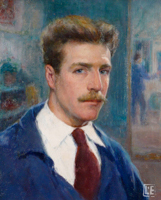
William L'Engle
Self Portrait, 1914
Oil on Canvas |
|
William J. L’Engle, Jr., was born in Jacksonville, Florida on April 22, 1884, a descendant of the Fatios, an historic name and prominent family. Francis Philip Fatio, Sr. (1724-1811), a Swiss native, brought his family and personal possessions to nearby St. Augustine and then developed his own plantation in Nueva Suiza, now known as Switzerland, Florida, on the St. John's River, about 8 years after Spain ceded Florida to Great Britain in 1763. After obtaining a crown grant of 10,000 acres, Fatio imported materials from England and built a country estate where he lived the life of a frontier baron. The plantation buildings were destroyed during the East Florida patriot revolt of 1812, one year after his death. Bill’s great grandmother was Susan Fatio L’Engle, a direct descendant of Col. John Washington, George Washington’s great grandfather. Bill came from a family that had a distinguished military heritage; men from his family served in the Revolutionary War and later on the Confederate side in the Civil War. Another forbearer, William Johnson, was an associate justice of the United States Supreme Court from 1804-1834.
|
|
|
|
| Bill attended Yale University and graduated in 1906 with a degree in naval architecture and was noted among his classmates for his skill as a draughtsman. He was also a star on the track team and held the mile record. After graduation, he inclined to the fine arts and attended the Art Students League in New York City. He then sought further artistic training in Paris. There, he spent 5 years studying at The Academie Julian with Richard E. Miller (1875-1943) and at the prestigious Ecole des Beaux-Arts with Jean Paul Laurens (1838-1924), and Louis Francois Biloul (1874-1947). In 1910, accompanied by friends and fellow artists Waldo Pierce (1884-1970), and George Biddle, (1885-1973), Bill travelled to Madrid, Spain. The young artists studied there and spent time at the Prado Museum copying paintings by the Spanish artist, Diego Velázquez. In 1914, William met the artist Lucy Stelle Brown, who had recently arrived in Paris at the Academie Julian. Soon thereafter, they were engaged and married. Their 1914 engagement photograph is at the top of this page. |
|
Lucy Brown L’Engle was born on September 26, 1889 to an affluent New York City family. Her father, Charles Stelle Brown was a very successful real estate broker in Manhattan for over 50 years. The firm is still active today as Brown, Harris, & Stevens. Her mother, Lucy Barnes Brown was the first U.S. Women’s Amateur Golf Champion in 1893. Lucy’s brother, former New York congressman Lathrop Brown, was Franklin Delano Roosevelt’s roommate at both Groton, a prep school in Massachusetts, and at Harvard University. They were such close friends that Lathrop was FDR’s best man at his wedding to Eleanor. Reportedly, FDR proposed to Lucy a few years before his marriage to Eleanor, however, Lucy declined. Instead of following a life in “high society” she showed early signs of a woman who possessed an independent mind, and chose a life devoted to the study of art. Family records indicate that Lucy may have visited Provincetown as early as 1909 to study with Charles Webster Hawthorne (1872-1930) at his Cape Cod School of Art. In 1911 she attended the Art Students League in New York City studying with George Brandt Bridgman (1864-1943), and others. In 1913 she furthered her studies in Paris at the Academie Julian where she studied with the cubist painter, Albert Gleizes (1881-1953).
|
|
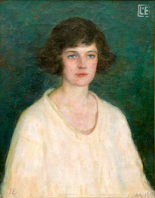 William L'Engle
William L'Engle
Portrait of Lucy, 1919
Oil on Canvas
|
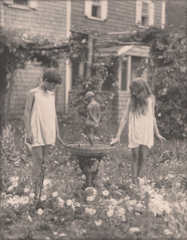
|
|
The couple’s first daughter, Madeleine, was born in Marseilles in 1915 during the family’s forced return to New York City due to the outbreak of WWI in France. They visited Provincetown in the summer of 1916 where Lucy continued to study at Hawthorne’s Cape Cod School of Art. Their second daughter, Camille, was born in New York in 1917.
The years 1916-1917 have become known as the “Cultural Moment” in America due to a “new” way of seeing, writing, painting and the new music, Jazz. William frequently took his subjects from the world of entertainment: dancers, acrobats, trapeze artists, wrestlers, and baseball players appear repeatedly in his work. He was greatly interested in the body in motion and in representing it solely by means of line. Dancers were a recurrent theme in the L’Engles’ art during the Twenties and Thirties.

At left: family photo of Madeleine and Camille, Truro, Massachusetts c.1924
|
|
|
|
| During this period, the L’Engles wintered at the Park Avenue apartment of Lucy’s father, Charles Stelle Brown, a few blocks from the dance studio of Martha Graham. They were fascinated by modern dance, enrolling their daughters in the children’s dance troupe of the legendary choreographer Isadora Duncan. William completed a large amount of drawings of the members of Martha Graham’s dance troupe and created a large number of watercolors and pencil drawings that captured the life and spirit of the Jazz Age, which emerged after the First World War and found its zenith in the Harlem nightclubs of New York City. Nightclub Dancer ca. 1930, oil on canvas; Harlem, a watercolor in the collection of the Provincetown Art Association and Museum; and a study for the same work, Girls Dancing, Harlem, 1930, Corcoran Gallery, Washington, D.C., are representative of this genre. The Corcoran describes this work and applies equally to Nightclub Dancer as: “In tight clothes, very sexy, and moving to a rhythmic beat, L’Engle’s dancers epitomize the then current view of blacks as primitive, exotic and highly sensual”. He achieved this end by using wavy lines and patterned repetition of shapes to create a sense of undulating, rhythmic motion.
The L’Engles continued to summer in Provincetown and were active participants in the town’s intellectual and social milieu including the formation of the Provincetown Players in 1916. Although exhibiting frequently at New York City galleries in the 1920s and 1930s, William is most closely associated with the modernist faction of the Provincetown Art Association, which included progressive artists such as BJO Nordfelt, Karl Knaths, Gerrit Beneker, Blanche Lazzell, and Agnes Weinrich. Lucy first joined and exhibited at The Provincetown Art Association in 1918.
|
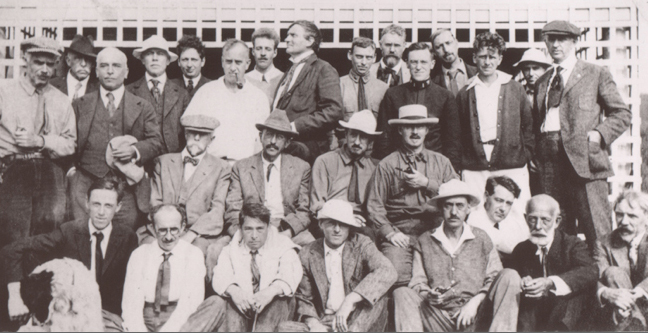
Early 1920's, Beachcombers. William L'Engle top row seventh from left, Charles W. Hawthorne, top row sixth from left, Eugene O'Neill, bottom row, fourth from right.
|
|
| This began a life-long affiliation with PAAM. Lucy again shows her independent side when she and fellow artist and friend, Marguerite Zorach, arrived in Provincetown in 1919 sporting “Bobbed Hairdos” - the latest in modern womens’ fashion and also a pre-cursor to the style of the “Roaring 20’s”. It was so daring at the time that their arrival was reported in the local newspaper, The Provincetown Advocate. |
|
|
|
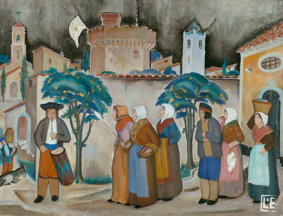
Bastille Day, Cavalier
1923, William L'Engle,
Oil on canvas
|
|
In 1923, the L’Engle family spent a rare summer away from Provincetown and traveled to France spending the summer in Cavalaire, a small town in Provence, with Albert Gleize and his wife. The author and playwright, Hutchins Hapgood and his wife, Neith Boyce and their family, visited there also. Hutch, as he was known, recollected in his book, “Victorian in the Modern World”, that Bill L’Engle, “loved the French in all their ways; he loved them temperamentally, perhaps because there was French blood in him, also his artist impulse felt the Gallic plastic quality”.
After Cavalaire, Lucy returned to Paris to study with Gleizes in 1923, confirming her interest in cubism. She later stated that, “I felt I could express myself which seemed exciting and important to me”. According to Tony Vevers in his catalog, “Lucy and William L’Engle”, 1999, “An overview of her work shows that her cubist pieces have a density about them that differs from her more anecdotal paintings of Truro, its hills and people.”

|
| In 1924, the L’Engles decided that Provincetown was too “busy” so they moved to the nearby town of Truro and purchased The Shebnah Rich house on Long Nook Road which became the L’Engles’ home, studio and source of inspiration and beauty for over 50 years. It was very much an artists’ and writers’ salon on the Outer Cape and they were well known for their wild artist parties! Bill was known for frolicking on the piano and keeping the parties hopping until the wee hours especially during the prohibition years.
A large number of artists with whom they were intimate in both Provincetown and Truro included: Charles Hawthorne and Marion Campbell, Eugene O’Neill, Gerrit Beneker, Oscar Gieberich, Susan Glaspell and George Cram Cook, John Dos Passos and Katherine Smith, Frank and Edith Shay, Hutchins Hapgood and Neith Boyce, Edmund Wilson and Mary McCarthy, William and Marguerite Zorach, Chauncey and Mary Hackett, Jerry Farnsworth and Helen Sawyer, Paul and Nina Chavchavadze, Polly Boyden, Eben and Thelma Given, Peggy and Clarence Day, Edna St.Vincent-Millay, Charles Demuth, Childe Hassam, Oliver Chaffee, Albert Gleizes, Francis and George Biddle, George and Shirley Yater, Edwin Dickinson, William Hallsall, Blanche Lazzell, Ross Moffett, Phyllis Duganne , E. Ambrose Webster, Karl Knaths and Helen Weinrich, Agnes Weinrich, Waldo and Mary Frank, Todd Lindenmuth and Elizabeth, Robert Nathan, Charles and Marguerite Kaseleau, Mary Heaton Vorse, Bruce McKain, Marston and Lucy Hodgins, Sheldon Dick, John and Tiny Worthington, Wilbur Daniel Steele and Marguerite, and Harry Kemp, “the poet of the dunes,” to name a few!
|
|
|
|
| In 1925 Lucy became a founding member of the New York Society of Women Artists (NYSWA) joining such noted Provincetown artists as Blanche Lazzell (1878-1956), Ellen Ravenscroft (1876-1949), Agnes Weinrich (1873-1946) and Marguerite Zorach (1887-1968), the NYSWA’s first president. In a review of their first show at the Anderson Galleries in New York in April 1926, the headline in the newspaper, Sunday World states, “Women Artists Show Prove That Painting and Sculpture are Not the Prerogatives of the Males.”
It was noted that this new group represented a more liberal and advanced wing in comparison to another women’s group called the National Association of Women Painters and Sculptors, considered by the NYSWA to be nothing more than “Sunday Painters” and was the impetus for starting their own group. In the article it states that, “Lucy L’Engle has braved the danger in her abstract canvasses which obviously recall Braque and Picasso. Her slighter works in one of the other rooms devoted to watercolors and drawings escape the imputation with more success.” This is really the first time that women artists were taken seriously and on their own terms.
|
|
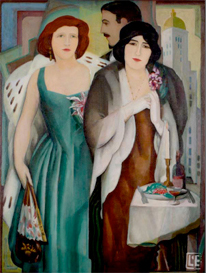
Madeleine and Thelma
1930, William L'Engle
Oil on canvas
|
|
Both William and Lucy served on the jury for the Provincetown Art Association’s First Modernist Exhibition in 1927. Bill was elected a trustee of the organization the following year in 1928. [At this time, in 2008, it appears that William and Lucy did show together during the 30s and 40s-(there is a record of William and Lucy having a joint show at the Bodley Gallery in New York City in 1955. Lucy showed individually, however, we have scant information as to the details). Bill also exhibited at the National Academy, Society of Independent Artists, Pennsylvania Academy of Fine Arts, and the Chicago Art Institute.
In New York City throughout the 20s and 30s, he exhibited at galleries such as The Montross Gallery, Georgette Passedoit Gallery, Kingore Gallery, and Bodley Gallery and was invited to exhibit his Cement Workers in the 1939 World’s Fair Exhibition. The Cement Workers is an example of Bill’s dedication to the genre of social realism. Other examples of this are seen in The Cranberry Pickers, (1926); Building New York, (1935); Stonington Mill, (1934); and The Six Day Bicycle Race (1935) donated by Lucy to The Whitney Museum of American Art in 1958. Interestingly enough, another example of Bill’s dedication to social realism was just discovered (February 2008), by the Town of Provincetown, MA. A painting called Track Meet, c.1926, was found behind another painting called, Axe at the Root, 1927 during a routine cleaning. This is not the first time that a William L’Engle painting has been found behind another William L’Engle painting during restoration. In 2006, a full eighty years after Bill painted Trapeze Artists in 1926, the rather playful painting was found behind Yulee Navy Base, 1946. We believe that William was not only utilizing a ready-made stretcher, but was also insuring future historic interest!
|
|
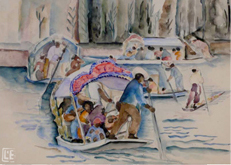
Xochimilco, Viva Mexico
William L'Engle
1933, Watercolor
|
|
In the 30s and 40s, Bill and Lucy traveled to Cuba, Mexico, and New Mexico. They painted some beautiful scenes such as: Xochimilco, Viva Mexico, 1933, William L’Engle; Cuban Scene, 1938, William L’Engle; Royal Palms, Cuba, 1938, Lucy L’Engle; and Local Traffic, 1938, William L’Engle. They also wintered in St. Augustine, Florida where they became part of a very active art colony now known as “The Lost Colony”. Bill had a long family history in that area as he was born in Jacksonville and one of his ancestors, Louisa Fatio (pronounced: Fa-shee-o ) is a renowned historical figure in St. Augustine known for being the proprietor of the “Ximenez-Fatio House” from 1855-1875. According to the St. Augustine Record, 12th of April, 1942, Bill talks about his personal view of St. Augustine: “It is a place unique in the United States, an easy going place that has resisted misguided efforts of business to hold fast to its sleepy drifting charm. A place where contacts could be taken or left alone. A peace so necessary to any creative work”. (For more information on the artists of The Lost Colony you can go to Robert W.Torchia’s excellent book, The Lost Colony, The Artists of St. Augustine, 1930-1950, published by The Lightner Museum, St. Augustine, Florida, 2001).
|
|
|
|
Some paintings of interest from this period that are found in the gallery are: St. John’s River, Bull Hiding, 1940, Lucy L’Engle; Castillo de San Marco, 1940, Lucy L’Engle; Yulee Navy Base, 1946, William L’Engle;. The 1950s were famous for abstract expressionism and Lucy and Bill both worked in that genre. Lucy produced a large body of lyrical abstract works with some quite spectacular results, such as: Abstraction, 1950; This Machine World, 1951; Abstract T, 1951; Les Alembiques, 1952.
Bill painted numerous abstract weather maps based upon The New York Times daily national weather map forecasts. He abstracted them and gave them a lyrical, musical quality; as seen in the isobars, which look like musical notes. A few examples are: Checkerboard Weather Map, 1953; Abstract Weather Map II, 1955. And, finally, toward the very end of Bill’s career and life he returned to figurative painting. One such rather “wild” painting is Lighthouse Nudes, 1954; and what appears to be one of his very last and rather terrifying paintings called, The Nightmare, 1954, seems to convey that the end was near. As far as we know, his very last painting was The Sacrifice of Abraham, 1957, the year of his death, explores an interpretation of the biblical story that has fascinated major artists throughout history.
After Bill’s death, Lucy donated a large number of William’s watercolors and pencil drawings from the 1930s of the Martha Graham Dance Troupe and Harlem nightclub scenes to the Lincoln Center Dance Collection, Museum of the City of New York, Cooper Hewitt Museum and the Staten Island Museum. When Lucy donated Bill’s pencil drawing, “Girls Dancing, Harlem”, 1930, to the Corcoran Gallery of Art in Washington D.C. circa 1959, she summarized his career in a letter with the donation: “His whole life was dedicated to painting the rather romantic subject of life as he saw it, and representing the beauty of his surroundings – as well as showing his deep love for it in a representational and non-representational way”.
Lucy was very dedicated to her husband’s memory and for several years exhibited his work in his former studio in Truro which was briefly known as the “L’Engle Studio Gallery”. The following dedication was written by the writer and Truro resident, Waldo Frank in 1959.
|
INSPIRATION...
"It is deeply fitting that the studio of William L’Engle, with his pictures on the walls, should become a place of contemplation and of creative thought for American artists and lovers of art; indeed for anyone in quest of his true self within the chaos, stupefying and unmanning, of contemporary life. For William L’Engle’s work is characterized above all by its fluid open-ness, its refusal of all dogma, its elegance of search, its grace of response to the winds and forms of doctrine, - as of a man firm in his own stance yet moved by many forces.
There was in William L’Engle’s sensitivity an acceptance of experiment, yet ever a withdrawal from the crass convention to which experiment can shrink. In his versatility there was a feminine submissiveness to the elements of nature backed by a final, very masculine self assertion. His art was eclectic, but not blatantly so; revealing always with a mordant critical sense, the aristocrats noblesse oblige. Like the Greeks, he admitted pain and blood, but never crudely.
Style, for him, glowed outward from within and was no surface imposition. It is plain to see how this restrainedly hospitable art could become a symbol for hospitality, a source of nutriment, to seekers of younger generations. And this makes clear the rightness of the plan to turn Bill L’Engle’s workshop into a haven for artists and for lovers of the devotion of artists, a sort of temple without theology and non-didactic, for them to pause and browse in."
- Waldo Frank
|
In the years after Bill’s death, Lucy became interested in archaic Greek, Hittite and Persian sculptures. She traveled with Marston Hodgins to Greece in 1964 and as she put it, “I went to Greece for the first time, filled with curiosity about the archaic sculptures that archaeology had uncovered”.
In 1969 she produced a catalog of her drawings called “Lucy L’Engle, My Personal Rediscovery of Archaic Greek Sculpture in Greece”, published by The Ram Press, New York. Previously, these drawings were shown at the Hotel Barbizon in 1965 and we believe it to be her last exhibition. Lucy died in Provincetown on March 14, 1978.
Written by Daniel L’Engle Davis and Teresa Izzo
Our thanks to: Mr. James Bakker, Mr. Tony Vevers, Mr. Robert W. Torchia
|

